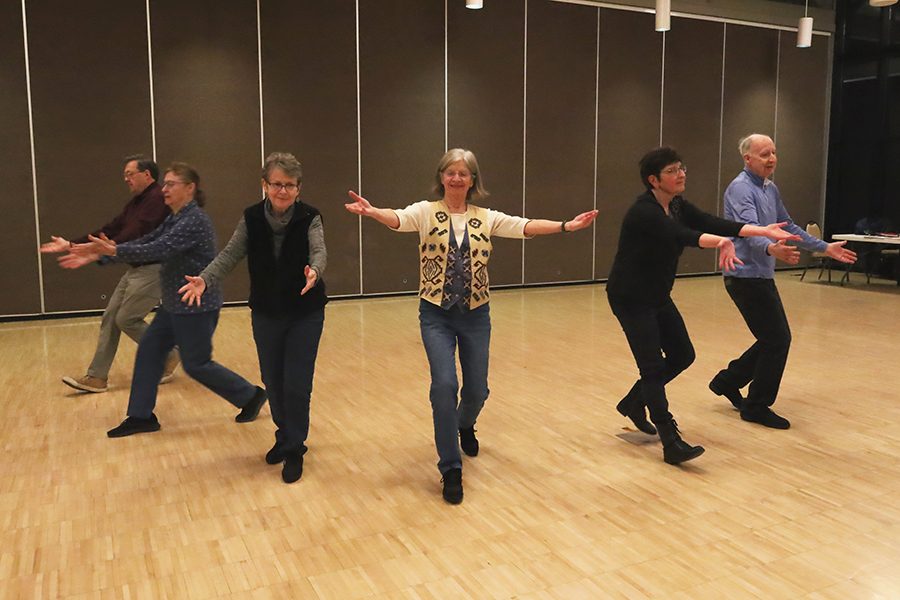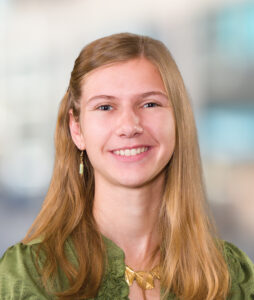
Home » Explore other cultures through dance with this Richland group
Explore other cultures through dance with this Richland group
International Folk Dancers of Richland hopes to inspire next generation to join

Members of the International Folk Dancers of Richland spend their Thursday evenings dancing to music from around the world. From left: Gene Carbaugh, Marilyn Young, Barbara Puigh, Gretchen Makinson, Maia Avtandilashvili and Ray Puigh.
Photo by Rachel VisickMarch 4, 2024
At first, the room is quiet except for the rhythmic sound of feet on floorboards, the occasional clapping of hands and a few words of explanation. Then the music kicks in and the dancers put what they’ve just learned into practice.
A dozen members of the International Folk Dancers of Richland spread out in a semicircle during a recent meetup as they danced a grapevine to the music, pinkie fingers linked. They had just learned a Turkish folk dance called Ali Pasha.
The club dates its origins to the 1940s, when Richland saw an influx of Hanford workers. “They wanted to do stuff, they didn’t just want to work all the time,” said Barbara Puigh of Richland, the club’s vice president. International Folk Dancers of Richland was officially incorporated in 1965.
Some of the dancers have been dancing for nearly that long – 40 years, 50 years or longer. The dances they perform are even older.
Though some choreographed dances are more recent, most of the folk dances have been around for hundreds of years. The dances are usually “village dances,” performed in a circle or line.
The club has focused on Balkan dances, which don’t require partners, but the dances come from a multitude of countries. The group dances to music from Romania, Bulgaria, Serbia, Poland, Ukraine, Israel, Turkey and more.
Some regions, like Scandinavia, tend to feature couple dances. These have become a little more difficult for the group, which is shrinking in size.
Over the years, the group has attracted members from other countries. Some of them were happy to see their dances being taught, Puigh said. When war broke out in Ukraine, the group chose to learn Ukrainian dances in solidarity.
Cultural learning is an important aspect in international folk dancing. The group used to host monthly ethnic potlucks with a different regional theme. “Then we’d dance off all those calories after,” recalled Mary Peters of Richland.
For Gretchen Makinson of Richland, folk dancing has had an impact on many different aspects of life. Meeting a dancer from Bosnia inspired her to travel there, and she also fell in love with the dancers’ costumes, ordering them from around the world and even making some of her own.
Attending festivals and meeting people with other backgrounds “just kind of broadens your perspective,” Makinson said.
Members of the group have attended many folk festivals, including local events such as Christ the King Sausage Fest and the Tumbleweed Music Festival. Often, there are opportunities to learn from a guest instructor from a different country.
During normal club dances, various members take turns teaching. The group has a binder of records on hand containing hard copies of dance instructions. And before that, “we had them on old 78 records,” said Gene Carbaugh of Richland, club secretary.

The International Folk Dancers of Richland put a dance they've just learned into practice at the Richland Community Center one Thursday evening.
| Photo by Rachel VisickHe taught several of the dances throughout the evening, demonstrating patterns of steps in the middle of the semicircle. Once everyone got the hang of the rhythm and order, they put the movements to music from a large speaker in the corner.
Those who have been with the group for a longer period of time know more advanced dances by heart. While the beginners took a break, they went straight to the dance floor without instruction to pull off an upbeat dance.
It’s clear that they love it. The Richland club is small and intimate; everyone knows each other, and they hardly ever miss a week. It’s about the camaraderie and friendship as much as the dancing.
A few dancers even met their spouses while dancing. Marilyn Young of Pasco met her late husband there — they were married over 45 years. John and Phyllis Brimhall, of West Richland, also met while folk dancing. They have been married for over 50 years and are still dancing into their late 80s and early 90s.
The first time Makinson danced, it was in college for a PE credit. “The very first time I did it, I was hooked,” she remembered.
Puigh described dancers who stick around this way: While some people take an art class to get credit and just abandon it, others “take art classes because they want to be an artist.”
Maia Avtandilashvili of Richland hadn’t done folk dancing before, but when Carbaugh invited her to come to a potluck, she stayed with the group. “It’s just fun,” she said.
The club’s shrinking size presents a bit of a challenge. While at one time the club had 50 or members or more, there are now less than 20. The answer lies in getting more people, especially younger generations, dancing.
For Peters, it’s “so exciting to see young people dancing here.”
A recent class the group held proved successful, introducing some people who had never danced before to folk dancing. Some of the class’s attendees now dance at the club’s regular meetings.
The International Folk Dancers of Richland intends to launch a new class for beginners to run for seven weeks starting in mid-March. They hope for it to take place in the hour before their weekly meetings so that new dancers can stay for the regular dances if they feel so inclined.
The dances are held 7-9 p.m. Thursdays at the Richland Community Center. New dancers are welcomed without a fee. A $4 donation is recommended to join in the dances in addition to an annual membership, which costs $12. The donations help offset the cost to rent the room each week and pay for insurance, events and involvement in other organizations.
Though some dancing experience is helpful, it is not necessary.
Those interested in joining the club may reach out to President Anne Schur at 509-946-9082 or iolitetanzi@gmail.com, or Carbaugh at 509-521-7653.
Senior Times
KEYWORDS March 2024





